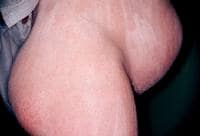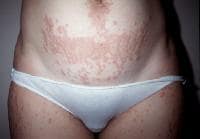Pregnancy, Urinary Tract Infections
Background
Urinary tract infections (UTIs) are one of the most common bacterial infections during pregnancy. UTIs are associated with risks to both the fetus and the mother, including pyelonephritis, preterm birth, low birth weight, and increased perinatal mortality. The prevalence rates of bacteriuria in pregnant women and nonpregnant women are essentially the same.1 UTIs are more common in women when compared with men, primarily because of the anatomic differences of the shorter urethra and its proximity to the vagina and the rectum. However, when pregnant women have a urinary tract infection, they have a higher risk for and increased occurrence of upper tract UTIs when compared with lower tract UTIs.
Several physiologic changes occur during pregnancy that cause otherwise healthy women to be more susceptible to serious sequelae from urinary tract infections.2 The infections can be symptomatic or asymptomatic. Asymptomatic bacteriuria, as the name implies, is a positive urine culture without specific symptoms. Asymptomatic bacteriuria increases the risk for an upper tract UTI, also known as pyelonephritis. Treatment of asymptomatic bacteriuria reduces the risk of a symptomatic infection.3
Pathophysiology
Remarkable changes occur in the structure and function of the urinary tract during pregnancy. Blood-volume expansion is accompanied by increases in the glomerular filtration rate (GFR) and urinary output. The ureters undergo tonic relaxation because of the mass production of hormones, particularly progesterone. This loss in tone, along with the increased urinary tract volume, results in urinary stasis, which, in turn, can lead to dilatation of the ureters and the calyceal pelves. Urinary stasis and the presence of vesicoureteral reflux predispose some women to upper tract UTIs and acute pyelonephritis.
Frequency
United States
The frequency of asymptomatic bacteriuria occurs in 2-7% of pregnancies, similar to the nonpregnant population. However, up to 40% of these may progress to symptomatic upper tract UTI or pyelonephritis, significantly more than in nonpregnant women.4 Several factors are associated with an increased frequency in various patient populations. Indigent patients have a 5-fold increased incidence of bacteriuria compared with that of nonindigent patients. The risk is doubled in women with sickle cell trait. Other risk factors for bacteriuria include diabetes mellitus, neurogenic bladder retention, and a history of previous urinary tract infections.
Mortality/Morbidity
Untreated upper tract UTIs are associated with low birth weight, prematurity, premature labor, hypertension,preeclampsia, maternal anemia, and amnionitis.5 A retrospective population-based study by Mazor-Dray et al showed that urinary tract infection during pregnancy is independently associated with intrauterine growth restriction, preeclampsia, preterm delivery, and cesarean delivery.6
Race
When socioeconomic status is controlled, no significance difference among the races seems to exist.
Sex
Urinary tract infections (UTIs) are 14 times more frequent in women than in men. This difference is attributed to several factors: (1) the urethra is shorter in women; (2) in women, the lower third of the urethra is continually contaminated with pathogens from the vagina and the rectum; (3) women tend not to empty their bladders as completely as men; and (4) exposure of the urogenital system to bacteria during intercourse.
Clinical
History
The presentation varies depending on whether the patient has asymptomatic bacteriuria, a lower tract UTI (cystitis), or an upper tract UTI (pyelonephritis).
- Pregnant women with asymptomatic bacteriuria usually are diagnosed incidentally on routine urinalysis and urine culture.
- Burning with urination (dysuria) is the most significant symptom in pregnant women with symptomatic cystitis.
- The usual complaints of increased frequency, nocturia, and suprapubic pressure are not particularly helpful, because most pregnant women experience these as a result of increased pressure from the growing uterus.
- Symptoms of pyelonephritis include the following:
- Fever (Often, the temperature is very high.)
- Chills
- Nausea and vomiting
- Costovertebral angle (CVA) or flank pain
Physical
A thorough physical examination is recommended, with particular attention to the abdomen.
- CVA tenderness may be present.
- Suprapubic tenderness may be present.
- The fetal heart rate should be noted.
- Pelvic examination is strongly recommended in all patients (with the exception of the third-trimester patient with bleeding) to rule out vaginitis or cervicitis.
Causes
- Escherichia coli (most common, in as many as 70% of cases)
- Group B Streptococcus (10%)
- Klebsiella or Enterobacter species (3%)
- Proteus species (2%)3
Other Problems to Be Considered
Pyelonephritis
Workup
Laboratory Studies
- In all pregnant patients, a urine specimen should be carefully collected for urinalysis and culturing during the first prenatal visit or at 12-16 weeks' gestation.
- These tests help to identify patients with asymptomatic bacteriuria as well as those with other specific complaints.
- For urine collection, a midstream clean catch is adequate, provided the patient is given careful instructions.
- Catheterization is indicated if the patient is unable to void, too ill, extremely obese, or bedridden.
- Two consecutive voided specimens with isolation of the same bacterial strain (100,000 CFU/mL) or a single catheterized specimen (100 CFU/mL) is diagnostic.7,2
- Counts of less than 100,000 CFU/mL, with 2 or more organisms, usually indicate a contamination rather than an infection.
- The leukocyte esterase test of the urine can be used as a screening examination for pyuria, although this test may be unreliable in patients with low-level pyuria (5-20 WBCs per high-power field).
- Patients with pyelonephritis often have WBC casts.
- Urine culturing should be performed in cases of suspected acute pyelonephritis, patients requiring hospitalization, and patients with a history of recent instrumentation or repeated infections.
- CBC, electrolyte, blood urea nitrogen (BUN), and creatinine tests should be ordered at the physician's discretion, although the results do not aid in the diagnosis or change treatment unless they are markedly abnormal.
Imaging Studies
- Unless anatomic abnormalities or renal disease is suspected, routine imaging studies are not necessary.
- In cases of persistent symptoms, persistent infection, or suspected urolithiasis, renal ultrasonography may be helpful.
Treatment
Emergency Department Care
Because of the dangers of maternal and fetal complications, care in the ED should be focused on identifying and treating patients with asymptomatic and symptomatic bacteriuria. Treatment of asymptomatic bacteriuria in pregnant patients is important because of the increased risk of urinary tract infection (UTI) and its associated sequelae.8 ED care may involve the following:
- Administration of appropriate antibiotics
- Administration of fluid if the patient is dehydrated
- Strongly consider admission if there is any indication of renal involvement
Consultations
An obstetrician may be consulted.
Medication
Antibiotic therapy for urinary tract infection should be initiated after all necessary cultures are obtained. If significant nausea or pain is present, appropriate medication may be indicated. Treatment of all symptomatic and asymptomatic patients with bacteriuria is important.
Antibiotics
Empiric antimicrobial therapy must be comprehensive and should cover all likely pathogens in the context of the clinical setting. Empiric coverage for E coli and Klebsiella, Proteus, and Enterobacter species should be provided.3
Penicillins and cephalosporins are safe for use during pregnancy. Ceftriaxone should be withheld close to parturition due to the possibility of neonatal kernicterus secondary to bilirubin displacement. Trimethoprim is a folic acid antagonist and should be avoided, especially during the first trimester. Fluoroquinolones and tetracyclines are known teratogens and are contraindicated in pregnancy.














